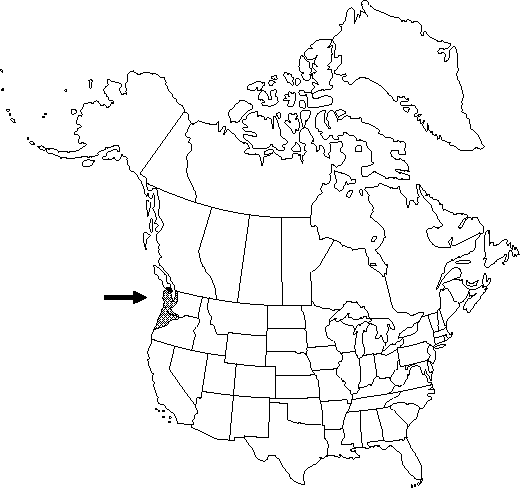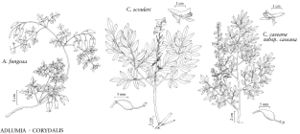FNA>Volume Importer |
FNA>Volume Importer |
| Line 23: |
Line 23: |
| | }}<!-- | | }}<!-- |
| | | | |
| − | --><span class="statement" id="st-d0_s0" data-properties="plant duration;rhizome size;rhizome texture"><b>Plants </b>perennial, from large, fleshy rhizomes.</span> <span class="statement" id="st-d0_s1" data-properties="stem quantity;stem some measurement"><b>Stems </b>1 or more, mostly 5-10 dm.</span> <span class="statement" id="st-d0_s2" data-properties="leaf quantity;leaf architecture;leaf some measurement"><b>Leaves </b>ca. 3, compound, 10 cm or more;</span> <span class="statement" id="st-d0_s3" data-properties="order quantity">blade with 3 orders of leaflets and lobes;</span> <span class="statement" id="st-d0_s4" data-properties="ultimate lobe arrangement or shape;ultimate lobe arrangement or shape;ultimate lobe arrangement or shape;ultimate lobe length;ultimate lobe width;ultimate lobe architecture or shape;apex shape;apex shape">ultimate lobes broadly elliptic or less commonly ovate to obovate with rounded apex, sometimes narrowly elliptic with acute apex, 1-8 × 0.5-4 cm, minutely apiculate.</span> <span class="statement" id="st-d0_s5" data-properties="inflorescence position;inflorescence position;inflorescence arrangement;inflorescence arrangement;inflorescence architecture"><b>Inflorescences </b>axillary or terminal, racemose or paniculate, 15-35-flowered on primary-axis;</span> <span class="statement" id="st-d0_s6" data-properties="beak prominence;proximal beak arrangement or shape;distal beak arrangement or course or shape;distal beak size">bracts inconspicuous, proximal bracts narrowly elliptic, distal linear and much reduced.</span> <span class="statement" id="st-d0_s7" data-properties="flower orientation"><b>Flowers </b>erect;</span> <span class="statement" id="st-d0_s8" data-properties="pedicel some measurement">pedicel 2-5 mm;</span> <span class="statement" id="st-d0_s9" data-properties="sepal duration;sepal shape;sepal shape;sepal shape;sepal some measurement;margin shape;margin shape">sepals caducous, ovate to broadly lanceolate, 1-2 mm, margins lacerate or dentate;</span> <span class="statement" id="st-d0_s10" data-properties="petal coloration;petal coloration;petal coloration;petal coloration">petals light to deep pink;</span> <span class="statement" id="st-d0_s11" data-properties="petal architecture or shape;petal course;petal some measurement;spur shape;spur some measurement;crest development;marginal wing presence">spurred petal usually somewhat curved, 20-25 mm, spur lanceoloid, 14-20 mm, crest well developed, usually exceeding petal apices, marginal wing absent;</span> <span class="statement" id="st-d0_s12" data-properties="outer petal architecture;outer petal shape;outer petal some measurement">unspurred outer petal boatshaped, 12-15 mm;</span> <span class="statement" id="st-d0_s13" data-properties="inner petal coloration;inner petal coloration;inner petal coloration;inner petal coloration;inner petal some measurement;blade width;claw size;blade variability">inner petals not tipped deep red or purple, usually 9-11 mm, blade much wider at apex, claw slender, equaling blade in length;</span> <span class="statement" id="st-d0_s14" data-properties="nectariferous spur length;nectariferous spur shape;nectariferous spur shape">nectariferous spur 1/2-2/3 length of petal spur, bent or hooked at apex;</span> <span class="statement" id="st-d0_s15" data-properties="style some measurement">style ca. 3 mm;</span> <span class="statement" id="st-d0_s16" data-properties="stigma shape;lateral papilla quantity;lateral papilla position;lateral papilla quantity">stigma roughly triangular, with 2 apical and 2 lateral papillae.</span> <span class="statement" id="st-d0_s17" data-properties="capsule orientation;capsule shape;capsule length;capsule width"><b>Capsules </b>reflexed, obovoid, 10-15 × 4-5 mm.</span> <span class="statement" id="st-d0_s18" data-properties="protuberance quantity;protuberance size"><b>Seeds </b>ca. 3.5 mm diam., with numerous small protuberances.</span> <span class="statement" id="st-d0_s19" data-properties="seed diameter;2n chromosome quantity">2n = ca. 130.</span><!-- | + | --><span class="statement" id="st-undefined" data-properties=""><b>Plants </b>perennial, from large, fleshy rhizomes. <b>Stems</b> 1 or more, mostly 5-10 dm. <b>Leaves</b> ca. 3, compound, 10 cm or more; blade with 3 orders of leaflets and lobes; ultimate lobes broadly elliptic or less commonly ovate to obovate with rounded apex, sometimes narrowly elliptic with acute apex, 1-8 × 0.5-4 cm, minutely apiculate. <b>Inflorescences</b> axillary or terminal, racemose or paniculate, 15-35-flowered on primary axis; bracts inconspicuous, proximal bracts narrowly elliptic, distal linear and much reduced. <b>Flowers</b> erect; pedicel 2-5 mm; sepals caducous, ovate to broadly lanceolate, 1-2 mm, margins lacerate or dentate; petals light to deep pink; spurred petal usually somewhat curved, 20-25 mm, spur lanceoloid, 14-20 mm, crest well developed, usually exceeding petal apices, marginal wing absent; unspurred outer petal boat-shaped, 12-15 mm; inner petals not tipped deep red or purple, usually 9-11 mm, blade much wider at apex, claw slender, equaling blade in length; nectariferous spur 1/2-2/3 length of petal spur, bent or hooked at apex; style ca. 3 mm; stigma roughly triangular, with 2 apical and 2 lateral papillae. <b>Capsules</b> reflexed, obovoid, 10-15 × 4-5 mm. <b>Seeds</b> ca. 3.5 mm diam., with numerous small protuberances. <b>2n</b> = ca. 130.</span><!-- |
| | | | |
| | -->{{Treatment/Body | | -->{{Treatment/Body |
| Line 54: |
Line 54: |
| | |publication year=1829 | | |publication year=1829 |
| | |special status=Endemic;Selected by author to be illustrated | | |special status=Endemic;Selected by author to be illustrated |
| − | |source xml=https://jpend@bitbucket.org/aafc-mbb/fna-fine-grained-xml.git/src/287ef3db526bd807d435a3c7423ef2df1e951227/V3/V3_396.xml | + | |source xml=https://jpend@bitbucket.org/aafc-mbb/fna-data-curation.git/src/9216fc802291cd3df363fd52122300479582ede7/coarse_grained_fna_xml/V3/V3_396.xml |
| | |genus=Corydalis | | |genus=Corydalis |
| | |species=Corydalis scouleri | | |species=Corydalis scouleri |
| − | |2n chromosome quantity=130
| |
| − | |apex shape=acute;rounded
| |
| − | |beak prominence=inconspicuous
| |
| − | |blade variability=equaling
| |
| − | |blade width=wider
| |
| − | |capsule length=10mm;15mm
| |
| − | |capsule orientation=reflexed
| |
| − | |capsule shape=obovoid
| |
| − | |capsule width=4mm;5mm
| |
| − | |claw size=slender
| |
| − | |crest development=developed
| |
| − | |distal beak arrangement or course or shape=linear
| |
| − | |distal beak size=reduced
| |
| − | |flower orientation=erect
| |
| − | |inflorescence architecture=15-35-flowered
| |
| − | |inflorescence arrangement=paniculate;racemose
| |
| − | |inflorescence position=terminal;axillary
| |
| − | |inner petal coloration=purple;red;deep;not tipped
| |
| − | |inner petal some measurement=9mm;11mm
| |
| − | |lateral papilla position=apical
| |
| − | |lateral papilla quantity=2;2
| |
| − | |leaf architecture=compound
| |
| − | |leaf quantity=3
| |
| − | |leaf some measurement=10
| |
| − | |margin shape=dentate;lacerate
| |
| − | |marginal wing presence=absent
| |
| − | |nectariferous spur length=1/2 length of petal spur;2/3 length of petal spur
| |
| − | |nectariferous spur shape=hooked;bent
| |
| − | |order quantity=3
| |
| − | |outer petal architecture=unspurred
| |
| − | |outer petal shape=boat-shaped
| |
| − | |outer petal some measurement=12mm;15mm
| |
| − | |pedicel some measurement=2mm;5mm
| |
| − | |petal architecture or shape=spurred
| |
| − | |petal coloration=light;deep pink
| |
| − | |petal course=curved
| |
| − | |petal some measurement=20mm;25mm
| |
| − | |plant duration=perennial
| |
| − | |protuberance quantity=numerous
| |
| − | |protuberance size=small
| |
| − | |proximal beak arrangement or shape=elliptic
| |
| − | |rhizome size=large
| |
| − | |rhizome texture=fleshy
| |
| − | |seed diameter=3.5
| |
| − | |sepal duration=caducous
| |
| − | |sepal shape=ovate;broadly lanceolate
| |
| − | |sepal some measurement=1mm;2mm
| |
| − | |spur shape=lanceoloid
| |
| − | |spur some measurement=14mm;20mm
| |
| − | |stem quantity=1
| |
| − | |stem some measurement=5dm;10dm
| |
| − | |stigma shape=triangular
| |
| − | |style some measurement=3
| |
| − | |ultimate lobe architecture or shape=apiculate
| |
| − | |ultimate lobe arrangement or shape=elliptic;less commonly ovate to obovate;elliptic
| |
| − | |ultimate lobe length=1cm;8cm
| |
| − | |ultimate lobe width=0.5cm;4cm
| |
| | }}<!-- | | }}<!-- |
| | | | |
| | -->[[Category:Treatment]][[Category:Corydalis]] | | -->[[Category:Treatment]][[Category:Corydalis]] |
Plants perennial, from large, fleshy rhizomes. Stems 1 or more, mostly 5-10 dm. Leaves ca. 3, compound, 10 cm or more; blade with 3 orders of leaflets and lobes; ultimate lobes broadly elliptic or less commonly ovate to obovate with rounded apex, sometimes narrowly elliptic with acute apex, 1-8 × 0.5-4 cm, minutely apiculate. Inflorescences axillary or terminal, racemose or paniculate, 15-35-flowered on primary axis; bracts inconspicuous, proximal bracts narrowly elliptic, distal linear and much reduced. Flowers erect; pedicel 2-5 mm; sepals caducous, ovate to broadly lanceolate, 1-2 mm, margins lacerate or dentate; petals light to deep pink; spurred petal usually somewhat curved, 20-25 mm, spur lanceoloid, 14-20 mm, crest well developed, usually exceeding petal apices, marginal wing absent; unspurred outer petal boat-shaped, 12-15 mm; inner petals not tipped deep red or purple, usually 9-11 mm, blade much wider at apex, claw slender, equaling blade in length; nectariferous spur 1/2-2/3 length of petal spur, bent or hooked at apex; style ca. 3 mm; stigma roughly triangular, with 2 apical and 2 lateral papillae. Capsules reflexed, obovoid, 10-15 × 4-5 mm. Seeds ca. 3.5 mm diam., with numerous small protuberances. 2n = ca. 130.
Phenology: Flowering mid spring–early summer.
Habitat: Moist, shady woods, particularly along streams
Elevation: 0-1100 m
Distribution
B.C., Oreg., Wash.
Discussion
Corydalis scouleri is restricted to cool, wet habitats from northwestern Oregon northward to Vancouver Island. It is most easily distinguished from Corydalis caseana by the usually highly developed crests and absence of wings on its outer petals. The stigma is essentially triangular (versus rectangular in C. caseana), and the capsule shape (typically obovoid) is rarely approached in C. caseana.
Selected References
None.

